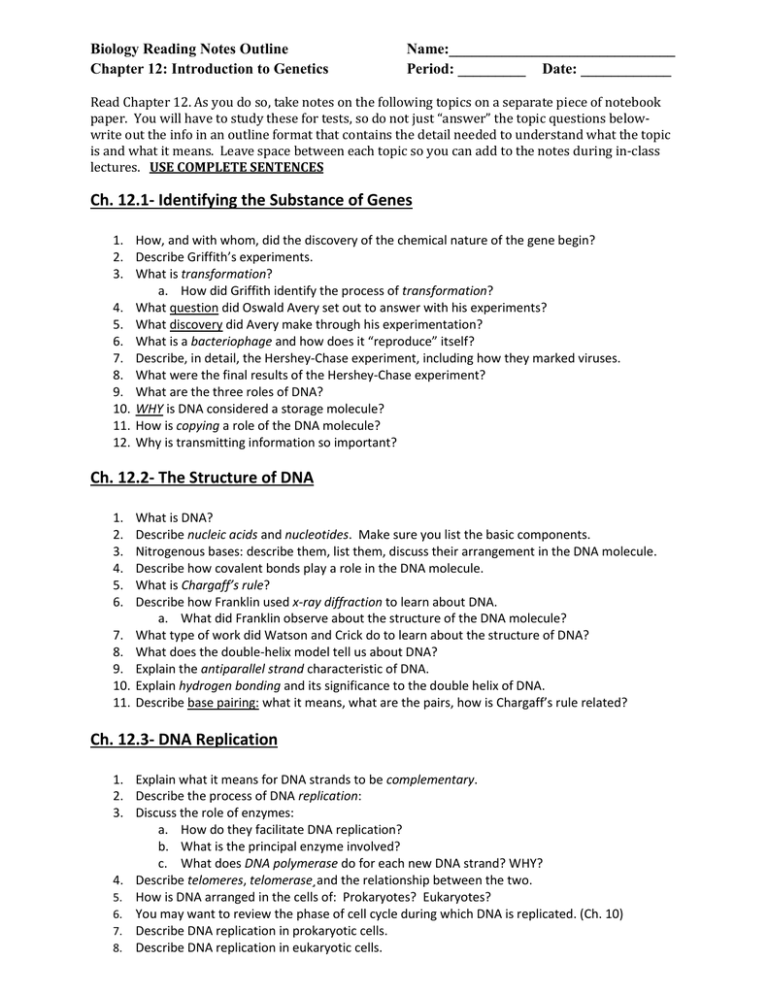Biology Reading Notes Outline Name:______________________________ Chapter 12: Introduction to Genetics
advertisement

Biology Reading Notes Outline Chapter 12: Introduction to Genetics Name:______________________________ Period: _________ Date: ____________ Read Chapter 12. As you do so, take notes on the following topics on a separate piece of notebook paper. You will have to study these for tests, so do not just “answer” the topic questions belowwrite out the info in an outline format that contains the detail needed to understand what the topic is and what it means. Leave space between each topic so you can add to the notes during in-class lectures. USE COMPLETE SENTENCES Ch. 12.1- Identifying the Substance of Genes 1. How, and with whom, did the discovery of the chemical nature of the gene begin? 2. Describe Griffith’s experiments. 3. What is transformation? a. How did Griffith identify the process of transformation? 4. What question did Oswald Avery set out to answer with his experiments? 5. What discovery did Avery make through his experimentation? 6. What is a bacteriophage and how does it “reproduce” itself? 7. Describe, in detail, the Hershey-Chase experiment, including how they marked viruses. 8. What were the final results of the Hershey-Chase experiment? 9. What are the three roles of DNA? 10. WHY is DNA considered a storage molecule? 11. How is copying a role of the DNA molecule? 12. Why is transmitting information so important? Ch. 12.2- The Structure of DNA 1. 2. 3. 4. 5. 6. 7. 8. 9. 10. 11. What is DNA? Describe nucleic acids and nucleotides. Make sure you list the basic components. Nitrogenous bases: describe them, list them, discuss their arrangement in the DNA molecule. Describe how covalent bonds play a role in the DNA molecule. What is Chargaff’s rule? Describe how Franklin used x-ray diffraction to learn about DNA. a. What did Franklin observe about the structure of the DNA molecule? What type of work did Watson and Crick do to learn about the structure of DNA? What does the double-helix model tell us about DNA? Explain the antiparallel strand characteristic of DNA. Explain hydrogen bonding and its significance to the double helix of DNA. Describe base pairing: what it means, what are the pairs, how is Chargaff’s rule related? Ch. 12.3- DNA Replication 1. Explain what it means for DNA strands to be complementary. 2. Describe the process of DNA replication: 3. Discuss the role of enzymes: a. How do they facilitate DNA replication? b. What is the principal enzyme involved? c. What does DNA polymerase do for each new DNA strand? WHY? 4. Describe telomeres, telomerase¸and the relationship between the two. 5. How is DNA arranged in the cells of: Prokaryotes? Eukaryotes? 6. You may want to review the phase of cell cycle during which DNA is replicated. (Ch. 10) 7. Describe DNA replication in prokaryotic cells. 8. Describe DNA replication in eukaryotic cells.